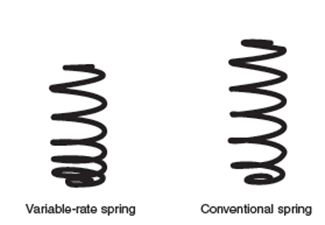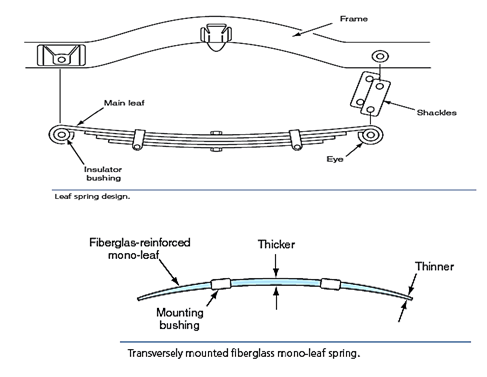Front Suspension System Components
Introduction:
The front and rear suspension systems must perform several extremely important functions to maintain vehicle safety and owner satisfaction. The suspension system must supply steering control for the driver under all road conditions. Vehicle owners expect the suspension system to provide a comfortable ride.
Coil Springs

- The coil spring is the most commonly used spring for front and rear suspension systems.
- Coil springs are actually a coiled-spring steel bar. When a vehicle wheel strikes a road irregularity, the coil spring compresses to absorb shock, and then recoils back to its original installed height.
- Coil springs do not have much ability to resist lateral movement. However, when coil springs are used on the drive wheels, the suspension usually has special bars to prevent lateral movement.
Torsion Bars
- A torsion bar is capable of storing a higher maximum energy compared with a loaded coil or leaf spring. Shorter, thicker torsion bars have increased load-carrying capacity compared with longer, thinner bars.
- Since torsion bars require less space compared with coil or leaf springs, they are usually found on front suspensions.
- However, a few rear suspensions have torsion bars. Torsion bars have a riding height adjustment screw at the end where they are attached to the frame.
Multiple-Leaf Springs

Multiple-leaf springs have a series of flat steel leaves of varying lengths that are clamped together. A center bolt extends through all the leaves to maintain the leaf position in the spring. An insulating bushing is pressed into each main leaf eye. The front bushing is attached to the frame, and the rear bushing is connected through a shackle to the frame.
Mono-Leaf Springs
Some leaf springs contain a single steel leaf, and these springs may be referred to as mono-leaf springs. The single leaf is thicker in the center and becomes gradually thinner toward the outer ends. This design provides a variable spring rate for a smooth ride and adequate load-carrying capacity.
Ball Joints
The ball joints act as pivot points that allow the front wheels and spindles, or knuckles, to turn between the upper and lower control arms. Compared with the earlier I-beam and kingpin-type front suspension systems, ball-joint suspension systems are much simpler.
Stabilizer Bar
The stabilizer bar is attached to the cross-member and interconnects the lower control arms. Rubber insulating bushings are used at all stabilizer bar attachment points.
Strut Rod
On some front suspension systems, a strut rod is connected from the lower control arm to the chassis. The strut rod is bolted to the control arm, and a large rubber bushing surrounds the strut rod in the chassis opening. The outer end of the strut rod is threaded and steel washers are positioned on each side of the strut rod bushing.